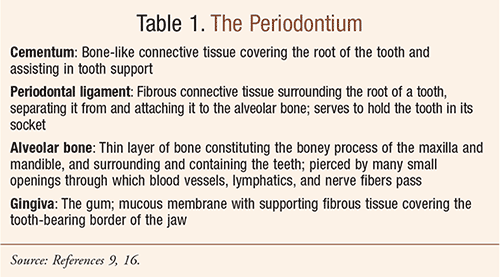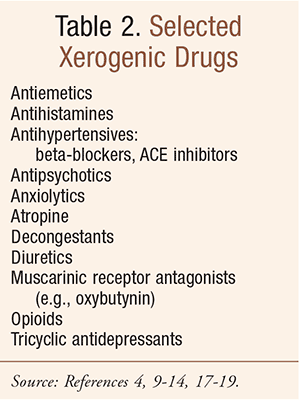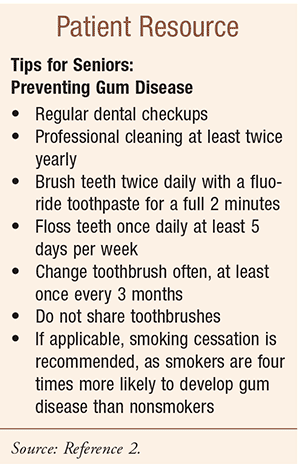US Pharm. 2016;(2):9-11.
Periodontitis, an inflammatory reaction triggered by bacteria in dental plaque, is the most severe form of gum disease and the leading cause of tooth loss in adults.1,2 Although some studies have suggested that periodontal disease may be a risk factor for heart disease, recent studies dispute that idea; however, reducing periodontal bacteria that can travel below the gum line to the heart is important for good health. This article discusses the diagnosis and treatment of periodontal disease, its implications for cardiac and overall health, and the impact of drugs and older age on oral health.
About 85% of the population is affected by chronic periodontitis to a mild degree, and <5% of the population experiences the most advanced cases; significant disease tends to be seen in those aged >35 years; tooth loss typically initiates in those about 40 years old.1 Periodontal disease appears increasingly with age; 70.1% of adults >65 years have periodontal disease.3 Significant disparities exist in some population groups, such that periodontitis is more common in men than women (56.4% vs. 38.4%); in those living below the federal poverty level (65.4%); in those with less than a high school education (66.9%); and in current smokers (64.2%).3
The periodontium is composed of the mucous membrane, connective tissue, and bone, providing an outer layer and support for the teeth (TABLE 1). Inflammation of the periodontium, or periodontitis, compromises these structures and exacerbates underlying and inadequately treated gingivitis (inflammation of the gum); usually, abundant plaque and calculus beneath the gingival margin are present.1 Additional characteristics include red and swollen gums. Tenderness and bleeding of gums may also occur, and foul breath may be detected. While symptoms of periodontitis are most often absent, development of an acute infection or abscess commonly causes pain and swelling. Anaerobic organisms can be harbored in the deep pockets caused by periodontitis; these organisms can do more damage than those found in simple gingivitis and trigger chronic release of inflammatory mediators, including cytokines, prostaglandins, and enzymes from neutrophils and monocytes.1 Furthermore, aspiration pneumonia involving anaerobic organisms in patients with periodontitis has a high mortality rate.4

Of note, in patients with a fever of unknown origin or a systemic infection of unknown cause, a dental disorder should be considered since severe bacteremias secondary to acute or chronic dental infection may contribute to brain abscesses, cavernous sinus thrombosis, endocarditis, and prosthetic joint infections.4
In periodontitis, the initiation of bone loss occurs secondary to progressive gingival detachment and a deepening of periodontal pockets; with progressive bone loss, the gingivae recede, the teeth loosen, and chewing becomes painful.1 Later stages of periodontitis commonly result in tooth migration and possible tooth loss.
Diagnosis and Treatment
Diagnosis involves inspection, periodontal probing, and, occasionally, x-rays.1 According to the American Academy of Periodontology’s classification system for periodontal diseases and conditions, there are four types of periodontitis: 1) chronic periodontitis (formerly called adult periodontitis)—the most common type—characterized by a slow rate of progression, periods of exacerbation and remission, and a correlation between the extent of destruction and the presence of local factors such as plaque; 2) aggressive periodontitis (formerly early-onset and juvenile periodontitis); 3) periodontitis as a manifestation of systemic diseases, in which patients have inflammation disproportionate to plaque or other local factors and who also have a systemic disease (e.g., acquired neutropenia, Down syndrome, Crohn’s disease); and 4) necrotizing ulcerative periodontitis (formerly called HIV periodontitis), which is especially virulent.1
Treatment of periodontitis consists of1:
• Treatment of modifiable risk factors (e.g., poor oral hygiene, diabetes, smoking), which has been shown to improve outcomes
• Dental cleaning that extends under the gums, referred to as scaling, and root planing (the removal of diseased or toxin-affected tissue followed by smoothing of the root) to remove plaque and calculus deposits
• Oral antibiotics (e.g., amoxicillin 500 mg po tid for 10 days) and/or antibiotic packs (i.e., gel containing doxycycline or microspheres of minocycline placed into isolated recalcitrant pockets; agents are resorbed in 2 weeks), which may be required in more advanced cases
• Surgery or tooth extraction
• A vigorous home oral hygiene program (e.g., brushing, flossing, rubber-tip massage), guided by a dental professional; it may also include chlorhexidine swabs or rinses.
Other treatments include:
• Pocket reduction/elimination surgery to remove the pocket and recontour bone
• Irrigation of the sulcus with povidone-iodine, regular use of chlorhexidine mouth rinses, and systemic antibiotics (e.g., metronidazole 250 mg po tid for 14 days) for necrotizing ulcerative periodontitis secondary to HIV
• Periodontal surgery plus oral antibiotics (e.g., amoxicillin 500 mg qid or metronidazole 250 mg tid for 14 days) for localized aggressive periodontitis.
Risk for Cardiovascular Disease?
Illnesses such as diabetes and cancer as well as hormonal changes during menopause can increase the risk of periodontal disease.2 Some studies have suggested that periodontal disease may be a risk factor for conditions such as diabetes and heart disease; however, recent studies have cast doubt on these associations, and more research is being conducted.2,5 The American Heart Association indicates that there is no evidence that preventing gum disease will prevent heart disease.6,7 However, periodontitis allows bacteria and other toxins to spread below the gum line, which can raise the level of systemic bacterial exposure.6
Of note, systemic bacterial exposure from periodontitis correlates poorly with the clinical examination.8 Studies do show that the bacteria found in periodontal disease—including Streptococcus sanguis, which plays a role in strokes—can spread to the myocardium.6 Furthermore, as mentioned above, anaerobic organisms from periodontitis trigger chronic release of inflammatory mediators, including cytokines, prostaglandins, and enzymes from neutrophils and monocytes that can have serious systemic implications.
According to a scientific statement from the American Heart Association, while observational studies to date support an association between periodontal disease and atherosclerotic vascular disease (ASVD) independent of known confounders, they do not, however, support a causal relationship.7 Furthermore, although periodontal interventions result in a reduction in systemic inflammation and endothelial dysfunction in short-term studies, there is no evidence that they prevent ASVD or modify its outcomes.7
Xerostomia
In the elderly, dry mouth, or xerostomia, is a common complaint; while meal-stimulated salivary flow is usually adequate with aging, resting salivary secretion diminishes and can be further diminished by drugs.4,9 Periodontal disease and tooth decay become more common without the cleansing and shielding effects of adequate salivary flow.10 Causes of xerostomia include mouth breathing, smoking, use of alcohol or caffeinated beverages, and a variety of medications (TABLE 2).9 Drug-associated xerostomia affects salivary flow rate or composition, either by causing a sensation of dry mouth or as a result of considerable hyposalivation.9,11 No specific medication has been identified as being more xerogenic; however, polypharmacy for multimorbidity increases the likelihood of dryness.9 Xerostomia is seen more commonly among individuals who take several medications, particularly if antipsychotic agents are among them.12

Agents most commonly implicated in dry mouth are antipsychotics, tricyclic antidepressants, beta-blockers, antihistamines, and atropine.13 It has been shown that advancing age and medication are related to objective evidence of hyposalivation, while female gender and psychiatric issues are strongly correlated with subjective complaints of oral dryness.14 Of note, while some medications can affect oral health because they lessen the flow of saliva, others, such as phenytoin and nifedipine, can cause gingival overgrowth.15 Management of xerostomia can be challenging and includes saliva substitutes, alcohol-free oral rinses, frequent sips of water, sugar-free gum and candy (to stimulate salivary flow), lubricating gels, restricting intake of caffeine/alcohol/carbonated beverages, and altering food consistency (e.g., blenderized diet); when xerostomia persists, a change in drug or dosage is often required.10,12
Benefits of Good Oral Health
While the American Heart Association indicates that there is no evidence that preventing gum disease will prevent heart disease, when oral health is compromised, a variety of illnesses and conditions can adversely impact an individual’s quality of life or life span.9 Timely access to care remains the key to maintaining oral health in the geriatric population.9 Community dwelling dependent seniors, homebound frail elderly, and long-term care facility residents face many more obstacles to receiving dental care than do healthy, independent seniors.9 By understanding periodontitis and how it afflicts both dentate and edentulous (missing all natural, permanent teeth)elderly adults, clinicians, including pharmacists, can help to improve oral health in seniors. See Patient Resource for gum disease prevention tips for seniors.

REFERENCES
1. Merck Manual. Periodontitis. Last full review/revision November 2015. www.merckmanuals.com/professional/dental-disorders/periodontal-disorders/periodontitis. Accessed January 11, 2016.
2. WebMD. Dangers of gum disease (video). www.webmd.com/oral-health/video/dangers-gum-disease. Accessed January 11, 2016.
3. Eke PI, Thornton-Evans G, Dye BA, Genco R. Advances in surveillance of periodontitis: the Centers for Disease Control and Prevention periodontal disease surveillance project. J Periodontol. 2012;83(11)1337-13342.
4. Merck Manual. Introduction to the approach to the dental patient. Last full review/revision August 2013. www.merckmanuals.com/professional/dental-disorders/approach-to-the-dental-patient/introduction-to-the-approach-to-the-dental-patient#Other. Accessed January 11, 2016.
5. Leng WD, Zeng XT, Kwong JS, and Hua XP. Periodontal disease and risk of coronary heart disease: An updated meta-analysis of prospective cohort studies. Int J Cardiol. 2015;201:469-472.
6. WebMD. Periodontal disease and heart health. Reviewed December 15, 2015. www.webmd.com/heart-disease/features/periodontal-disease-heart-health. Accessed January 8, 2016.
7. Lockhart PB, Bolger AF, Papapanou PN, et al. Periodontal disease and atherosclerotic vascular disease: does the evidence support an independent association? A scientific statement from the American Heart Association. Circulation. 2012;125(20):2520-2544.
8. Mustapha IZ, Debrey S, Oladubu M, et al. Markers of systemic bacterial exposure in periodontal disease and cardiovascular disease risk: a systematic review and meta-analysis. J Periodontol. 2007;78(12):2289-2302.
9. Schreiber A, Glickman R. Geriatric dentistry: oral health in the geriatric population. In: Fillit HM, Rockwood K, Woodhouse K, eds. Brocklehurst’s Textbook of Geriatric Medicine and Gerontology. 7th ed. Philadelphia, PA: Saunders Elsevier; 2010:599-607.
10. American Dental Association. Do you have dry mouth? JADA. October 2002;133:1455.
11. Wynn RL, Meiller TF. Drugs and dry mouth. Gen Dent. 2001;49:10-14.
12. Pajukoski H, Meurman JH, Halonen P, et al. Prevalence of subjective dry mouth and burning mouth in hospitalized elderly patients and outpatients in relation to saliva, medication and systemic diseases. Oral Surg Oral Med Oral Pathol Oral Radiol Endod. 2001; 92(6):641-649.
13. Streckfus CF. Salivary function and hypertension: a review of the literature and a case report. J Am Dent Assoc. 1995;126:1012-1017.
14. Bergdahl M, Bergdahl J. Low unstimulated salivary flow and subjective oral dryness: association with medication, anxiety, depression and stress. J Dent Res. 2000;79:1652-1658.
15. Epocrates.com. Epocrates Plus. Version 15.11. Updated January 13, 2016. Accessed January 13, 2016.
16. Dorland’s Pocket Medical Dictionary. 28th ed. Philadelphia, PA: Saunders Elsevier; 2009:115,153,362,480,639.
17. Scully C. Drug effects on salivary glands: dry mouth. Oral Dis. 2003; 9(4):165-176.
18. Thomson WM, Chalmers JM, Spencer AJ, et al. Medication and dry mouth: findings from a cohort study of older people. J Public Health Dent. 2000; 60:12-20.
19. Merck Manual. Xerostomia. Last full review/revision August 2014. www.merckmanuals.com/professional/dental-disorders/symptoms-of-dental-and-oral-disorders/xerostomia. Accessed January 13, 2016.
To comment on this article, contact rdavidson@uspharmacist.com.





